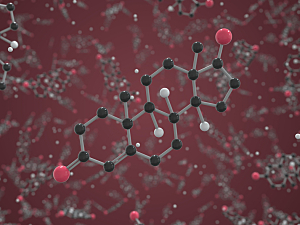Measuring serum testosterone (T) levels in women aids in diagnosing androgen excess disorders, such as polycystic ovary syndrome, hirsutism, and congenital adrenal hyperplasia. However, accurate measurement is challenging because women’s levels are so much lower than men’s, there is marked variability among assays, and women’s levels change substantially during the menstrual cycle.
Grace Huang, MD, of the Boston Claude D. Pepper Older Americans Independence Center (Boston OAIC) and the Division of Endocrinology, Diabetes and Hypertension at Brigham and Women’s Hospital, Ravi Jasuja, PhD, lecturer on Medicine at the Brigham and director of the Metabolic Phenotyping Core in the Boston OAIC, and colleagues examined changes in T and dihydrotestosterone (DHT) levels using state-of-the-art assays that exhibit a high level of precision and accuracy in the low range.
In Fertility and Sterility, they report higher levels of total and free T than have been reported previously, emphasizing the importance of establishing menstrual phase–specific reference ranges.
Methods
The researchers recruited 21 healthy women, ages 19 to 40 years, who had regular menstrual cycles for at least three months. In contrast to previous studies where hormone measurements were limited to two or three time points, fasting blood samples were taken every three days across two menstrual cycles.
Total T and DHT levels were measured using liquid chromatography–tandem mass spectrometry, a highly sensitive and specific method certified by the CDC. Free T levels were measured by equilibrium dialysis, considered the reference method. Sex hormone binding globulin (SHBG) was measured with a two-site immunofluorometric assay.
Participants were asked to maintain menstrual diaries, and luteinizing hormone (LH) levels were measured every three days to track the timing of ovulation (i.e., LH peak). 17 participants with complete data for at least one menstrual cycle and no outlier LH levels were included in the analysis. Their mean age was 27.
Data on 59 healthy men from the 5a-Reductase Trial, ages 19 to 40, who had normal T levels (300–1,200 ng/dL) were also included in the analyses.
Androgen Levels in Women
Mean changes in androgens during the menstrual cycle were the following:
- Total T—increased from 15.6 ng/dL in the early luteal phase to a peak of 43.6 ng/dL at mid-cycle (P=0.01); no significant differences between the luteal and follicular phases
- Free T—increased from 9.00 pg/mL in the early luteal phase to 15.6 pg/mL at mid-cycle (P=0.05)
- Mean DHT level—no significant change
- Ratio of total T to DHT—no significant change
- SHBG—substantial variation but no significant change
The pattern of change in total and free T levels was consistent with previously published studies. Still, the absolute T levels in this study were higher than values reported in some prior studies.
DHT-to-T Ratio in Women vs. Men
In all phases of the menstrual cycle, women had a DHT level one-fourth of the total T level. For men, DHT was one-thirteenth of total T. Women also had significantly higher SHBG levels than men.
These results remained unchanged after adjustment for age and body mass index. It hasn’t been widely appreciated that women have significantly higher DHT levels relative to total T than men do, and the clinical significance of this finding is unknown.
Toward Better Clinical Decision-making
The T assays used at commercial laboratories don’t consider the menstrual cycle phase in which the blood was collected. Furthermore, commercial laboratories don’t report the procedural details of the equilibrium dialysis, sampling method, or characteristics of the participants from which their reference ranges are derived.
These data highlight the need to establish cycle-related physiologic reference ranges and re-evaluate the reference values provided by commercial laboratories to avoid the potential for misdiagnosis of androgen disorders.
